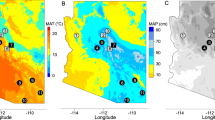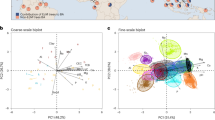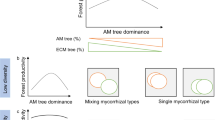Abstract
Forestry reshapes ecosystems with respect to tree age structure, soil properties and vegetation composition. These changes are likely to be paralleled by shifts in microbial community composition with potential feedbacks on ecosystem functioning. Here, we assessed fungal communities across a chronosequence of managed Pinus sylvestris stands and investigated correlations between taxonomic composition and extracellular enzyme activities. Not surprisingly, clear-cutting had a negative effect on ectomycorrhizal fungal abundance and diversity. In contrast, clear-cutting favoured proliferation of saprotrophic fungi correlated with enzymes involved in holocellulose decomposition. During stand development, the re-establishing ectomycorrhizal fungal community shifted in composition from dominance by Atheliaceae in younger stands to Cortinarius and Russula species in older stands. Late successional ectomycorrhizal taxa correlated with enzymes involved in mobilisation of nutrients from organic matter, indicating intensified nutrient limitation. Our results suggest that maintenance of functional diversity in the ectomycorrhizal fungal community may sustain long-term forest production by retaining a capacity for symbiosis-driven recycling of organic nutrient pools.
Similar content being viewed by others
Log in or create a free account to read this content
Gain free access to this article, as well as selected content from this journal and more on nature.com
or
References
Averill C, Hawkes CV . (2016). Ectomycorrhizal fungi slow soil carbon cycling. Ecol Lett 19: 937–947.
Averill C, Turner BL, Finzi AC . (2014). Mycorrhiza-mediated competition between plants and decomposers drives soil carbon storage. Nature 505: 543–545.
Baldrian P . (2014). Distribution of extracellular enzymes in soils: spatial heterogeneity and determining factors at various scales. Soil Sci Soc Am J 78: 11–18.
Baldrian P, Kolařík M, Štursová M, Kopecký J, Valášková V, Větrovský T et al. (2012). Active and total microbial communities in forest soil are largely different and highly stratified during decomposition. ISME J 6: 248–258.
Baskaran P, Hyvönen R, Berglund SL, Clemmensen KE, Ågren GI, Lindahl BD et al. (2016). Modelling the influence of ectomycorrhizal decomposition on plant nutrition and soil carbon sequestration in boreal forest ecosystems. New Phytol e-pub ahead of print 17 October 2016; doi: 10.1111/nph.14213.
Boberg JB, Finlay RD, Stenlid J, Ekblad A, Lindahl BD . (2014). Nitrogen and carbon reallocation in fungal mycelia during decomposition of boreal forest litter. PLoS One 9: e92897.
Bödeker ITM, Clemmensen KE, de Boer W, Martin F, Olson Å, Lindahl BD . (2014). Ectomycorrhizal Cortinarius species participate in enzymatic oxidation of humus in northern forest ecosystems. New Phytol 203: 245–256.
Bödeker ITM, Lindahl BD, Olson Å, Clemmensen KE . (2016). Mycorrhizal and saprotrophic fungal guilds compete for the same organic substrates but affect decomposition differently. Funct Ecol 30: 1967–1978.
Chatterjee A, Vance GF, Pendall E, Stahl PD . (2008). Timber harvesting alters soil carbon mineralization and microbial community structure in coniferous forests. Soil Biol Biochem 40: 1901–1907.
Clemmensen KE, Bahr A, Ovaskainen O, Dahlberg A, Ekblad A, Wallander H et al. (2013). Roots and associated fungi drive long-term carbon sequestration in boreal forest. Science 339: 1615–1618.
Clemmensen KE, Ihrmark K, Brandström-Durling M, Lindahl BD . (2016). Sample preparation for fungal community analysis by high-throughput sequencing of barcode amplicons. In: Martin F, Uroz S (eds). Microbial Environmental Genomics (MEG). Springer: New York, NY, USA, pp 61–88.
Clemmensen KE, Finlay RD, Dahlberg A, Stenlid J, Wardle DA, Lindahl BD . (2015). Carbon sequestration is related to mycorrhizal fungal community shifts during long-term succession in boreal forests. New Phytol 205: 1525–1536.
Croft H, Chen JM, Noland TL . (2014). Stand age effects on boreal forest physiology using a long time-series of satellite data. For Ecol Manag 328: 202–208.
Dahlberg A . (2001). Community ecology of ectomycorrhizal fungi: an advancing interdisciplinary field. New Phytol 150: 555–562.
Dahlberg A . (2002). Effects of fire on ectomycorrhizal fungi in Fennoscandian boreal forests. Silva Fenn 36: 69–80.
Dahlberg A, Stenström E . (1991). Dynamic changes in nursery and indigenous mycorrhiza of Pinus sylvestris seedlings planted out in forest and clearcuts. Plant Soil 135: 73–86.
Deslippe JR, Hartmann M, Mohn WW, Simard SW . (2011). Long-term experimental manipulation of climate alters the ectomycorrhizal community of Betula nana in Arctic tundra. Glob Chang Biol 17: 1625–1636.
Edgar RC . (2010). Search and clustering orders of magnitude faster than BLAST. Bioinformatics 26: 2460–2461.
Eichlerová I, Homolka L, Žifčáková L, Lisá L, Dobiášová P, Baldrian P . (2015). Enzymatic systems involved in decomposition reflects the ecology and taxonomy of saprotrophic fungi. Fungal Ecol 13: 10–22.
Fernandez CW, Kennedy PG . (2016). Revisiting the ‘Gadgil effect’: do interguild fungal interactions control carbon cycling in forest soils? New Phytol 209: 1382–1394.
Gadgil RL, Gadgil PD . (1975). Suppression of litter decomposition by mycorrhizal roots of Pinus radiata. N Z J For Sci 5: 33–41.
Goslee SC, Urban DL . (2007). The ecodist package for dissimilarity-based analysis of ecological data. J Stat Softw 22: 1–19.
Grebenc T, Christensen M, Vilhar U, Čater M, Martín MP, Simončič P et al. (2009). Response of ectomycorrhizal community structure to gap opening in natural and managed temperate beech-dominated forests. Can J For Res 39: 1375–1386.
Hagenbo A, Clemmensen KE, Finlay RD, Kyaschenko J, Lindahl BD, Fransson P et al. (2016). Changes in turnover rather than production regulate biomass of ectomycorrhizal fungal mycelium across a Pinus sylvestris chronosequence. New Phytol e-pub ahead of print 20 December 2016; doi: 10.1111/nph.14379.
Hart SA, Chen HYH . (2006). Understory vegetation dynamics of North American boreal forests. Crit Rev Plant Sci 25: 381–397.
Hartmann M, Howes CG, VanInsberghe D, Yu H, Bachar D, Christen R et al. (2012). Significant and persistent impact of timber harvesting on soil microbial communities in Northern coniferous forests. ISME J 6: 2199–2218.
Hesse CN, Mueller RC, Vuyisich M, Gallegos-Graves LV, Gleasner CD, Zak DR et al. (2015). Forest floor community metatranscriptomes identify fungal and bacterial responses to N deposition in two maple forests. Front Microbiol 6: 337.
Hobbie EA, Agerer R . (2010). Nitrogen isotopes in ectomycorrhizal sporocarps correspond to belowground exploration types. Plant Soil 327: 71–83.
Ihrmark K, Bödeker ITM, Cruz-Martinez K, Friberg H, Kubartova A, Schenck J et al. (2012). New primers to amplify the fungal ITS2 region—evaluation by 454-sequencing of artificial and natural communities. FEMS Microbiol Ecol 82: 666–677.
Jandl R, Lindner M, Vesterdal L, Bauwens B, Baritz R, Hagedorn F et al. (2007). How strongly can forest management influence soil carbon sequestration? Geoderma 137: 253–268.
Jones MD, Durall DM, Cairney JWG . (2003). Ectomycorrhizal fungal communities in young forest stands regenerating after clearcut logging. New Phytol 157: 399–422.
Jurgensen MF, Harvey AE, Graham RT, Page-Dumroese DS, Tonn JR, Larsen MJ et al. (1997). Impacts of timber harvesting on soil organic matter, nitrogen, productivity, and health of inland northwest forests. For Sci 43: 234–251.
Kennedy PG, Peay KG, Bruns TD . (2009). Root tip competition among ectomycorrhizal fungi: are priority effects a rule or an exception? Ecology 90: 2098–2107.
Kohler A, Kuo A, Nagy LG, Morin E, Barry KW, Buscot F et al. (2015). Convergent losses of decay mechanisms and rapid turnover of symbiosis genes in mycorrhizal mutualists. Nat Genet 47: 410–417.
Koide RT, Fernandez C, Malcolm G . (2014). Determining place and process: functional traits of ectomycorrhizal fungi that affect both community structure and ecosystem function. New Phytol 201: 433–439.
Konôpka B, Pajtík J, Marušák R . (2015). Biomass allocation influenced by canopy closure in a young spruce stand. J Forest Sci 61: 62–71.
Kreutzweiser DP, Hazlett PW, Gunn JM . (2008). Logging impacts on the biogeochemistry of boreal forest soils and nutrient export to aquatic systems: a review. Environ Rev 16: 157–179.
Kõljalg U, Nilsson RH, Abarenkov K, Tedersoo L, Taylor AFS, Bahram M et al. (2013). Towards a unified paradigm for sequence-based identification of fungi. Mol Ecol 22: 5271–5277.
Lilleskov EA, Bruns TD, Horton TR, Taylor DL, Grogan P . (2004). Detection of forest stand-level spatial structure in ectomycorrhizal fungal communities. FEMS Microbiol Ecol 49: 319–332.
Lindahl BD, Clemmensen KE . (2016). Fungal ecology in boreal forest ecosystems. In: Martin F (ed). Molecular Mycorrhizal Symbiosis. John Wiley & Sons, Inc.: Hoboken, New Jersey, NY, USA, pp 387–404.
Lindahl BD, de Boer W, Finlay RD . (2010). Disruption of root carbon transport into forest humus stimulates fungal opportunists at the expense of mycorrhizal fungi. ISME J 4: 872–881.
Lindahl BD, Nilsson RH, Tedersoo L, Abarenkov K, Carlsen T, Kjøller R et al. (2013). Fungal community analysis by high-throughput sequencing of amplified markers—a user’s guide. New Phytol 199: 288–299.
Lindahl BD, Tunlid A . (2015). Ectomycorrhizal fungi—potential organic matter decomposers, yet not saprotrophs. New Phytol 205: 1443–1447.
Magnani F, Mencuccini M, Borghetti M, Berbigier P, Berninger F, Delzon S et al. (2007). The human footprint in the carbon cycle of temperate and boreal forests. Science 447: 848–852.
Moorhead DL, Sinsabaugh RL . (2006). A theoretical model of litter decay and microbial interaction. Ecol Monogr 76: 151–174.
Nylund JE, Wallander H . (1992). Ergosterol analysis as a means of quantifying mycorrhizal biomass. Method Microbiol 24: 77–88.
Näsholm T, Höberg P, Franklin O, Metcalfe D, Keel SG, Campbell C . (2013). Are ectomycorrhizal fungi alleviating or aggravating nitrogen limitation of tree growth in boreal forests? New Phytol 198: 214–221.
Parrent JL, Morris WF, Vilgalys R . (2006). CO2-enrichment and nutrient availability alter ectomycorrhizal fungal communities. Ecology 87: 2278–2287.
Peay KG, Bruns TD . (2014). Spore dispersal of basidiomycete fungi at the landscape scale is driven by stochastic and deterministic processes and generates variability in plant–fungal interactions. New Phytol 204: 180–191.
Peltoniemi M, Mäkipää R, Liski J, Tamminen P . (2004). Changes in soil carbon with stand age—an evaluation of a modelling method with empirical data. Glob Chang Biol 10: 2078–2091.
R Core Team. (2015). R: a language and environment for statistical computing. R Foundation for Statistical Computing, Vienna, Austria.
Read DJ . (1991). Mycorrhizas in ecosystems. Experientia 47: 376–391.
Read DJ, Perez-Moreno J . (2003). Mycorrhizas and nutrient cycling in ecosystems: a journey towards relevance? New Phytol 157: 475–492.
Saiya-Cork KR, Sinsabaugh RL, Zak DR . (2002). The effects of long term nitrogen deposition on extracellular enzyme activity in an Acer saccharum forest soil. Soil Biol Biochem 34: 1309–1315.
Schneider T, Keiblinger KM, Schmid E, Sterflinger-Gleixner K, Ellersdorfer G, Roschitzki B et al. (2012). Who is who in litter decomposition? Metaproteomics reveals major microbial players and their biogeochemical functions. ISME J 6: 1749–1762.
Smolander A, Priha O, Paavolainen L, Steer J, Mälkönen E . (1998). Nitrogen and carbon transformation before and after clear-cutting in repeatedly N-fertilized and limed forest soil. Soil Biol Biochem 30: 477–490.
Sterkenburg E, Bahr A, Brandström-Durling M, Clemmensen KE, Lindahl BD . (2015). Changes in fungal communities along a boreal forest soil fertility gradient. New Phytol 207: 1145–1158.
Sun H, Santalahti M, Pumpanen J, Köster K, Berninger F, Raffaello T . (2015). Fungal community shifts in structure and function across a boreal forest fire chronosequence. Appl Environ Microbiol 81: 7869–7880.
Tamura K, Stecher G, Peterson D, Filipski A, Kumar S . (2013). MEGA6: molecular evolutionary genetics analysis version 6.0. Mol Biol Evol 30: 2725–2729.
Taylor AFS, Martin F, Read DJ . (2000). Fungal diversity in ectomycorrhizal communities of Norway spruce [Picea abies (L.) Karst.] and beech (Fagus sylvatica L.) along North-South transects in Europe. In: Schulze ED (ed). Carbon and Nitrogen Cycling in European Forest Ecosystems. Springer-Verlag: Berlin, pp 343–365.
Twieg BD, Durall DM, Simard SW . (2007). Ectomycorrhizal fungal succession in mixed temperate forests. New Phytol 176: 437–447.
Wallander H, Johansson U, Sterkenburg E, Brandström-Durling M, Lindahl BD . (2010). Production of ectomycorrhizal mycelium peaks during canopy closure in Norway spruce forests. New Phytol 187: 1124–1134.
White TJ, Bruns T, Lee S, Taylor J . (1990). Amplification and direct sequencing of fungal ribosomal RNA genes for phylogenetics. In: Innis MA, Gelfand DH, Sninsky JJ, White TJ (eds). PCR Protocols: A Guide to Methods and Applications. Academic Press: New York, NY, USA, pp 315–322.
Acknowledgements
This research was supported by the Swedish Research Council FORMAS (grant 2011-1747) to BDL. Bergvik Skog AB is gratefully acknowledged for providing study sites. We also thank three reviewers for their constructive comments which greatly improved the quality of the manuscript.
Author contributions
JK, KEC, AH, EK and BDL designed the study. JK, KEC and BDL conducted field sampling. JK performed the laboratory work and data analysis. JK wrote the first draft of the manuscript and all authors contributed substantially to data interpretations and revisions.
Author information
Authors and Affiliations
Corresponding author
Ethics declarations
Competing interests
The authors declare no conflict of interest.
Additional information
Supplementary Information accompanies this paper on The ISME Journal website
Supplementary information
Rights and permissions
About this article
Cite this article
Kyaschenko, J., Clemmensen, K., Hagenbo, A. et al. Shift in fungal communities and associated enzyme activities along an age gradient of managed Pinus sylvestris stands. ISME J 11, 863–874 (2017). https://doi.org/10.1038/ismej.2016.184
Received:
Revised:
Accepted:
Published:
Issue date:
DOI: https://doi.org/10.1038/ismej.2016.184
This article is cited by
-
Ectomycorrhizal fungal community varies across broadleaf species and developmental stages
Scientific Reports (2025)
-
Mediterranean co-living: succession of soil mycorrhizal communities associated with Halimium lasianthum shrubs
European Journal of Forest Research (2025)
-
Shifts in ectomycorrhizal exploration types complement root traits in nutrient foraging of alpine coniferous forests along an elevation gradient
Plant and Soil (2025)
-
Tree Biomass Improves Soil Microhabitat in Pinus massoniana Forests of Central China
Journal of Soil Science and Plant Nutrition (2025)
-
Contrasting fungal community assembly mechanisms in bulk soil and rhizosphere of Torreya grandis across a 900-year age gradient
Plant and Soil (2025)



